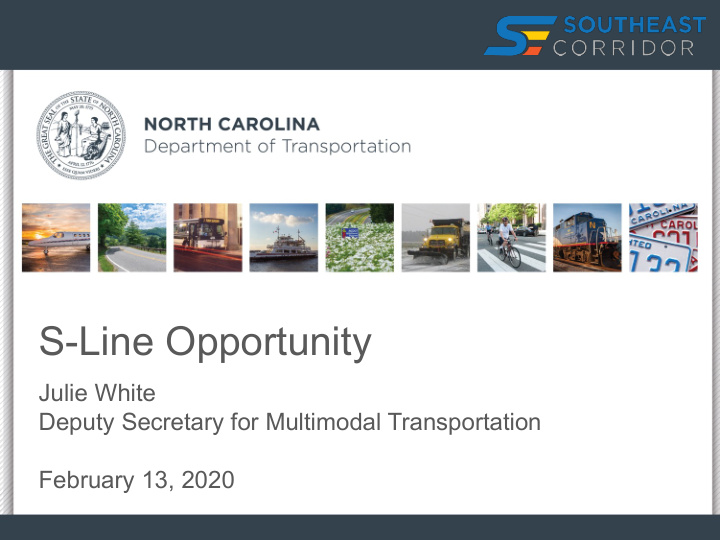



S-Line Opportunity Julie White Deputy Secretary for Multimodal Transportation February 13, 2020
North Carolina Railroad System 2
Connectivity Economic Development Congestion Population Growth Mobility What problems in our region can be solved by multimodal transportation? Affordable Housing Jobs Infrastructure Improving Urban/Rural Connections
S-Line Connectivity • Connect rural and urban communities • Expand access for freight and megasites • Provide economic development opportunities Moncure Estimated Travel Times Megasite Henderson-Raleigh 40 minutes Wake Forest-Raleigh 20 minutes Raleigh-Roanoke Rapids 90 minutes Sanford-Raleigh 40 minutes Southern Pines-Cary 58 minutes Estimated time subject to further analysis.
Stakeholder Meetings • Local, State, and Federal Elected Officials • City and County Engineering, Planning, and Development Staff • Transit Agencies, MPOs, RPOs, Advocacy Groups, Chambers of Commerce • Economic Development Professionals, Developers, Financial Consultants, Rail Advisory Industry Leaders, Railroads
Preparing for CRISI 2020 – How You Can Help CRISI (Consolidated Rail Infrastructure and Safety Improvements) 2020 Resolutions in support of the development of the • House and Senate updated language for S-Line and SA-Line have the CRISI program – now allows for right been passed by: of way acquisition up to $45M – Town of Franklinton • Opportunity for the State of North Carolina – Town of Sanford – ROW funding available: $45M – Town of Wake Forest – Federal/local match minimum: 80/20 – Lee County Board of Commissioners • Resolutions of Support will make the – Wake Forest Chamber grant application stronger of Commerce
About the S-Line Jason Orthner, P.E. Rail Division Director February 13, 2020
History of the S-Line The S-Line was once a primary rail route. Freight train north of Franklinton Passenger train near present day Spring Forest Road
Virginia & CSX Landmark Rail Agreement • State of VA purchased 350 miles of railroad right away and 225 miles of track • State ownership allows for: – Control of land and access – On-time service – Implementation of future technologies VA Acquired Rail Corridor – Economic development along the corridors
Existing Conditions on the S-Line • Petersburg to Ridgeway – Out of service, tracks removed – Recently purchased by State of Virginia S-Line • Ridgeway to Raleigh – 25 mph, local freight traffic only • Raleigh to Hamlet – 60 mph, local freight and passenger service
Raleigh to Richmond S-Line is the Missing Link • Critical link in the federally- designated Southeast Corridor • Will expand and improve passenger and freight services • Will reduce passenger trip times and improve on-time performance • Will increase north-south freight Designated SEC capacity and rail network Tracks Removed resiliency Current Passenger • Will connect manufacturing and Service job centers to population centers
Acquisition of the S-Line • Builds upon Virginia’s acquisition • Allows for continued growth and development of the corridor as a critical transportation link • Supports the expansion of freight service on the line • Aligns with upcoming CRISI grant opportunity
CRISI Program Background • Consolidated Rail Infrastructure & Safety Improvements Program created as a part of the FAST Act and administered by FRA • Individual project awards have ranged from: – $58K to $10M (FY 17) – $157K to $34M (FY 18) • NCDOT Awards: – $10M (FY 17) – $34M (FY 18) • Funding: – Projects require at least 80/20 match – Projects with multiple non-federal sources 13
Anticipated CRISI Features for FY 2020 • All previous features • Additional funding category for Right of $325M Way (ROW) – $45 Million reserved for projects that available require ROW acquisition, track, or funding track structure • Late Spring / Early Summer Release of Funding Opportunity 14
Next Steps Building on Virginia’s Success • Encourage governing and community authorities to pass resolutions and provide monetary support for CRISI application • Compete for CRISI 2020 for corridor acquisition • Partner with MPOs, RPOs, and communities to progress corridor development and planning • Secure funding for incremental projects through STI and federal discretionary grants to improve rail infrastructure for new rail services
Recommend
More recommend